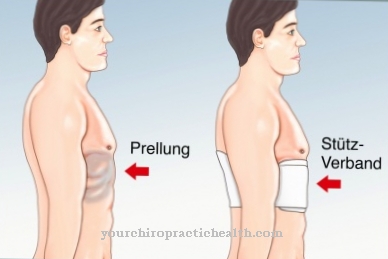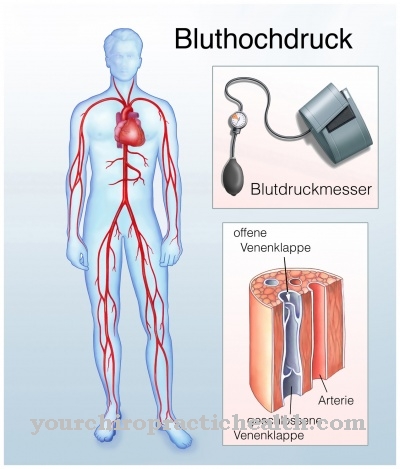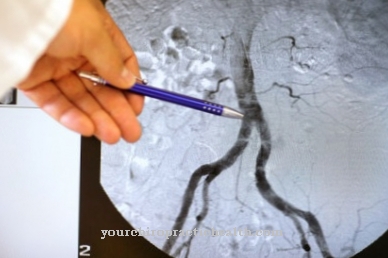With Apnea or Apnea is called a complete interruption of external breathing. Respiratory arrest can have many different causes, ranging from willful interruption to illnesses to certain trauma or poisoning with neurotoxins. After just a few minutes, respiratory arrest becomes critical due to the onset of insufficient oxygen supply.
What is respiratory failure?

© bilderzwerg - stock.adobe.com
Complete cessation of external breathing is known as cessation of breath or apnea. Respiratory arrest can occur voluntarily by simply holding one's breath or it can be caused by external factors. In the case of an involuntary pause in breathing, either the breathing reflex is temporarily or permanently disturbed or the respiratory muscles are paralyzed. In the vast majority of cases, the respiratory arrest is caused by a traumatic brain injury (TBI).
A mechanical blockage of the airways can also interrupt breathing, for example with sleep apnea. The gas exchange in the capillaries of the alveoli, like the gas exchange in the capillaries within the tissue, is initially retained for a short time.
Only after the oxygen in the remaining air volume in the lungs has been used up does the exchange of carbon dioxide for molecular oxygen and vice versa come to a standstill. This not only results in an insufficient supply of oxygen (hypoxia), but also a dangerous overconcentration of carbon dioxide, which causes hyperacidity.
causes
There can be a wide variety of reasons for not breathing, which require different measures to be taken to correct the problem. By far the most common causes are obstructive sleep apnea syndrome and so-called cranial brain trauma (TBI). Obstructive sleep apnea blocks the upper airways while you sleep.
The smooth circular muscles around the upper airways relax so much that the upper part of the windpipe mutates into a tube with tension-free walls. The slight negative pressure that occurs when you breathe in causes the walls to “collapse”, creating the blockage. TBI, which can result from an accident, is usually accompanied by loss of consciousness and failure of many brain functions. In more severe cases, the respiratory center can also be so disturbed that the breathing reflex fails to occur and respiratory arrest occurs.
Paralysis of the respiratory muscles through illness or through poisoning with neurotoxins can also lead to respiratory failure. A blow to the solar plexus nerve plexus as a result of an accident or other violence can trigger a reflex that causes the respiratory muscles to cramp, so that a (mostly) temporary respiratory arrest occurs.
You can find your medication here
➔ Medication for shortness of breath and lung problemsSymptoms, ailments & signs
External signs of respiratory failure are unconsciousness, the absence of any air flow through the nose or mouth, dilated pupils and a slight blue discoloration of the skin (cyanosis), which shows up after a few minutes. Persistent respiratory failure initially leads to a lack of oxygen (hypoxia), so the internal organs and the brain are also irreversibly damaged, so that the person affected can die of organ failure. Sometimes various symptoms such as headaches, nausea, but also euphoria and strong self-overestimation are possible. These are symptoms that are typically also observed in altitude sickness.
In the worst case, those affected can die if the respiratory failure is not treated in time. In some cases, even after treatment, the brain can be so badly damaged that people have reduced intelligence or other disabilities and psychological problems from breathing failure.
This significantly reduces the quality of life of the person affected. If the respiratory arrest lasts for about ten minutes, the patient will die in most cases. Mouth-to-mouth resuscitation can prevent death until the emergency doctor arrives.
Diagnosis & course
This leads to a rapid increase in the concentration of carbon dioxide in the blood, which is supposed to trigger the maximum stimulus in the respiratory center to trigger a spontaneous breath. The lack of oxygen is accompanied by a dangerous increase in the concentration of carbon dioxide in the blood, which usually triggers a strong breathing reflex, if the patient has stopped breathing.
Remarkably, when the carbon dioxide concentration rises even further, the breathing reflex weakens again and comes to a complete standstill. In the further course, symptoms of poisoning and irreversible damage to the nerve cells in the brain appear. If no immediate countermeasures are taken, death from suffocation is inevitable.
If this does not happen, there is a total failure of the respiratory center, an important criterion for determining brain death. For example, one of the ultimate tests for suspected brain death is to ventilate the person who has stopped breathing with pure oxygen while reducing ventilation.
Complications
A respiratory failure must be treated directly by a doctor or in the hospital. If the respiratory arrest is left untreated, it leads to death in most cases. Death occurs when the brain and other organs have not been supplied with oxygen for too long and are severely damaged as a result.
If a patient has suffered from respiratory arrest and was then resuscitated, the degree of injury depends heavily on how long the organs were not supplied with oxygen. If you stop breathing for a short time, it is assumed that most organs will not be damaged. After that, the brain works without much difficulty. After the respiratory arrest itself, the patient complains of severe headaches and nausea.
If the breathing stops for a long time, the brain will be damaged. After that, certain parts of the brain can no longer function properly, which can lead to thinking disorders. It is not uncommon for the brain to no longer control certain parts of the body properly. If the respiratory arrest lasts longer, this usually leads to death and also to cardiac arrest. Resuscitation must be carried out immediately to avoid damaging the organs.
When should you go to the doctor?
If a person stops breathing, his life is in grave danger. Every respiratory arrest is therefore a reason to call the emergency doctor and have the cause clarified after the necessary rescue measures. At best, in the event of a respiratory arrest, one person provides first aid while another contacts the emergency doctor, because if the patient is not helped immediately, he or she may die within a few minutes due to the lack of oxygen.
Even if he survives the respiratory failure or starts breathing again on its own, after a long time it is questionable how great the damage to the brain is. The affected person could be severely disabled or unable to wake up at all, even if he breathes again.
Many respiratory arrests do not even happen in such dramatic situations, but only last for a short time and are sometimes not even consciously noticed - for example in cases of sleep apnea. Still, they're just as dangerous as in any other case. In the case of sleep apnea, however, the emergency doctor does not need to be called immediately, as those affected start breathing again on their own.
However, a medical examination must still be carried out in order to avoid really dangerous situations and to prevent breathing stops at night. In infants and young children, sudden cessation of breathing is the trigger for sudden infant death syndrome, which is why children at risk, such as premature babies, should be medically monitored as a precaution.
Doctors & therapists in your area
Treatment & Therapy
The various causes of respiratory arrest require immediate measures to remedy the respiratory arrest or - if that is not possible - to circumvent it. When treating a respiratory arrest, which is a life-threatening situation, it is imperative to act quickly, as serious damage to health threatens within a few minutes. If the respiratory arrest is caused by a mechanical obstruction of the upper airway by a foreign body, the removal of the foreign body provides immediate relief.
If removal is not possible, an immediate tracheal incision (cricothyrotomy) below the larynx can save life. The same measure may also be necessary in the case of allergic reactions to an insect bite in the throat, if the swelling of the tissue tightly seals the windpipe. In the many cases in which respiratory failure is coupled with cardiovascular failure, resuscitation measures are required.
The measures range from simple chest compressions, coupled with mouth-to-mouth resuscitation, to the use of a defibrillator and injections or infusions. The chest compressions, which are performed at a frequency of about 100 to 120 per minute by rhythmic pressure on the sternum, should be replaced by 2 attempts at ventilation after every 30 presses.
In the event of a respiratory arrest caused by neurotoxins, narcotics or intoxicants, in addition to resuscitation measures in certain cases such as snake bites or fungal poisoning, antidotes are available, which at best neutralize the toxins. If certain neurological diseases are present that cause permanent impairment of natural breathing, permanent active ventilation using suitable equipment may be necessary.
Outlook & forecast
The prospect and prognosis of respiratory arrest depend on the exact cause of the respiratory arrest and on how quickly breathing starts again. If, on the other hand, breathing stops at all, death from suffocation is the result after a few minutes. A subsequent attempt at resuscitation can still be successful after several minutes, but in almost all cases it will result in severe and irreversible brain damage. These occur after just three minutes without oxygen and can affect all areas of the brain.
A lack of oxygen as a result of suspended breathing leads to hypoxemia within a very short time and then to organ and brain damage. Occasional interruptions in breathing for a few seconds are normal for many people (as part of a sleep apnea, for example) and have no acute damaging effect. However, long-term damage due to a recurring brief lack of oxygen is possible.
An apnea that can be traced back to mechanical causes (strangulation, swallowing, etc.) can usually be ended by removing the trigger. Organic causes - especially nerve and muscle damage - mean in the event that they bring breathing to a standstill, usually that breathing can no longer be initiated by the person concerned. Until the causal disease is cured, he is initially dependent on artificial respiration.
In general, the faster a person who suffers respiratory arrest - regardless of the cause - is ventilated, the better the prognosis for the consequential damage. Respiratory arrests that cannot be traced back to a complete organic failure can therefore be bridged until the cause is found.
You can find your medication here
➔ Medication for shortness of breath and lung problemsprevention
Due to the variety of possible causes of respiratory arrest, preventive measures that could prevent respiratory arrest are hardly possible. General preventive measures are to keep yourself healthy and not abuse alcohol or other drugs.
Aftercare
Whether follow-up treatment is necessary as a result of respiratory arrest depends primarily on the cause. Neurological diseases and damage to the respiratory muscles can repeatedly cause the familiar symptoms. In these cases, it is essential to see the doctor again. The situation is different, however, when acute causes lead to respiratory arrest.
A power accident or strangulation cannot be expected again. A recurrence can therefore be ruled out, which is why follow-up examinations are not necessary after a complete recovery. Sometimes the symptoms of respiratory arrest cannot be treated at all. This is particularly the case if the breath stops for a long period of time.
The brain is damaged as described above. This leads to the fact that certain organs can no longer be properly controlled. Recurring complications such as respiratory failure can occur again and again. Those affected must therefore visit a doctor regularly for follow-up care.
In order to live symptom-free in everyday life, patients can receive help in order to reduce the factors favoring an illness. Basically, nicotine, alcohol and drugs should be avoided. Follow-up care may also include training family members on how to resuscitate a patient who has stopped breathing.
You can do that yourself
If breathing stops, first aid measures must be taken immediately. If necessary, the person concerned must be removed from the danger zone before further treatment can take place. It is best to put the person affected in a stable lateral position and immobilize them.
If necessary, resuscitation measures such as mouth-to-mouth resuscitation must be carried out on site. In addition, the emergency doctor should be alerted immediately. Based on the W questions, the emergency services must be given all relevant information so that immediate treatment is possible.
Further self-measures depend on the cause of the respiratory failure. If the cause is a foreign body, it must be carefully removed from the mouth or throat. The head should be turned to one side so that vomit can drain away. If pollutants or poisons are suspected as the cause, no respiratory donation should be carried out.
Cardiopulmonary resuscitation makes more sense in this case. After the initial respiratory arrest has been treated, rest and bed rest apply. The person concerned should recover for a few days and then slowly return to everyday life. In conversation with a therapist, the respiratory failure can be worked through in order to avoid the development of psychological problems.

.jpg)











.jpg)

.jpg)
.jpg)











.jpg)